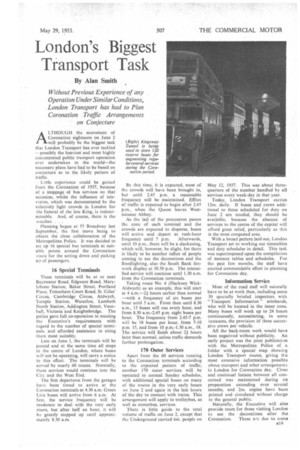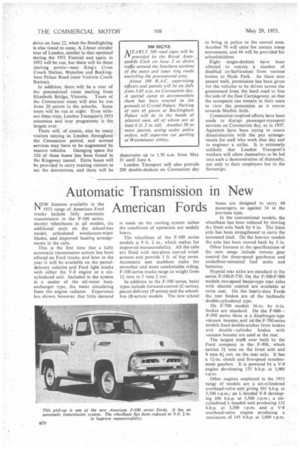London's Biggest Transport Task
Page 53

Page 54

If you've noticed an error in this article please click here to report it so we can fix it.
By Alan Smith Without Previous Experience of any Operation Under Similar Conditions, London Transport has had to Plan Coronation Traffic Arrangements on Conjecture
ALTHOUGH the movement of Coronation sightseers on June 2 will probably be the biggest task that London Transport has ever tackled —possibly the heaviest and most highly concentrated public transport operation ever undertaken in the world—the necessary plans have had to be based on conjecture as to the likely pattern of traffic.
Little experience could be gained from the Coronation of 1937, because of a stoppage of bus services on that occasion, whilst the influence of television, which was demonstrated by the relatively light crowds in London for the funeral of the late King, is indeterminable. And, of course, there is the weather. . . .
Planning began at 55 Broadway last September, the first move being to obtain the close collaboration of the Metropolitan Police. It was decided to set up 16 special bus terminals at suitable points around the Coronation route for the setting down arid picking up of passengers.
16 Special Terminals
These terminals will be at or near Bayswater Road, Edgware Road, MaryleboneStation, Baker Street, Portland Place, Tottenham Court Road, St. Giles' Circus, Cambridge Circus, Aldwych, Temple Station, Waterloo, Lambeth North Station, Addington Street, Vauxhall, Victoria and Knightsbridge. The police gave full co-operation in meeting the Executive's requirements with regard to the number of special terminals, and afforded assistance in siting them most suitably.
Late on June 1, the terminals will be posted and at the same time all stops in the centre of London, where buses will not be operating, will carry a notice to this effect. The terminals will be served by nearly 60 routes. Normally, these services would continue into the City and the West End.
The first departures from the garages have been timed to arrive at the Coronation terminals at 4.30 a.m. Green Line buses will arrive from 6 a.m. At first, the service frequency will be moderate to deal with the very early risers, but after half an hour, it will 1:r greatly stepped up until approximately 8.30 a.m. By this time, it is expected, most of the crowds will have been brought in, but until 2.45 p.m. a reasonable frequency will be maintained. Efflux of traffic is expected to begin after 2.45 p.m., when the Queen leaves Westminster Abbey.
As the tail of the procession passes the zone of each terminal and the crowds are expected to disperse, buses will arrive and depart at rush-hour frequency until 7 p.m. Afterwards, until 10 p.m., there will be a slackening, which will, however, be slight, for there is likely to be another influx of people coming to see the decorations and the floodlighting, also the South Bank firework display at 10.30 p.m. The intensified service will continue until 1.30 a.m. from the Coronation terminals.
Taking route No. 6 (Hackney WickAldwych) as an example, this will start at 4 a.m.-2+ hours earlier than normal —with a frequency of six buses per hour until 5 a.m. From then until 8.30 a.m., 15 buses will run every hour, and from 8.30 a.m.-2.45 p.m. eight buses per hour. The frequency from 2.45-7 p.m. will be 18 buses per hour, from 7-10 p.m. 15, and from 10 p.m.-130 am., 18. The service will finish about 21 hours later than normal, unless traffic demands further prolongation.
170 Outer Services
Apart from the 60 services running to the Coronation terminals accOrding to the expected pattern of traffic, another 170 outer services will be operated to normal Sunday schedules, with additional. special buses on many of the routes in the very early hours on June 2 and again in the late hours of the day to connect with trains. This arrangement will apply to trolleybus, as well as motorbus, services.
There is little guide to the total volume of traffic on June 2, except that the Underground carried bm. people on May 12, 1937, This was about threequarters of the number handled by all services every week-day in that year.
Today, London Transport carries 12m. daily. If buses and crews additional to those scheduled for duty on June 2 are needed, they should be available, because the absence of services to the centre of the capital will afford great relief, particularly as this is the most congested area.
With a broad pattern laid out, London Transport set to working out timetables and duty schedules in detail. This task was superimposed upon the compilation. of Summer tables and schedules. For the past few months, the staff have exerted commendable effort in planning for Coronation day.
Information Service
Most of the road staff will naturally have to be at work then, including some 30 specially briefed inspectors with " Transport Information" armbands, who will be located in the inner zone. Many buses will work up to 24 hours continuously, necessitating, in some instances, the provision of three successive crews per vehicle.
All the back-room work would have been negatived without publicity. An early project was the joint publication with the Metropolitan Police of a folder with a special map showing London Transport routes, giving the most extensive information possible about transport and other arrangement:I iii London for Coronation day. Close and continual liaison between all concerned was maintained during its preparation extending over several months, and 2m. copies have been printed and circulated without charge to the general public.
Naturally, the Executive will also provide tours for those visiting London to see the decorations after the Coronation. These are due to come clown on June 22, when the floodlighting is also timed to cease. A 2-hour circular tour of London, similar to that operated during the 1951 Festival and again in 1952 will be run, but there will be three starting points—near King's Crass Coach Station, Waterloo and Buckingham Palace Road (near Victoria Coach Station).
In addition, there will be a tour of the processional route starting from Elizabeth Bridge, Victoria. Tours of the Coronation route will also be run from 20 points in the suburbs. Some tours will be run at night. Even without these trips, London Transport's 1953 excursion and tour programme is the largest ever.
There will, of course, also be many visitors staying in London throughout the Coronation period, and normal services may have to be augmented by reserve vehicles Garaging space for 120 of these buses has been found in the Kingsway tunnel. Extra buses will be provided to carry evening visitors to see the decorations, and there will be departures up to 1.30 a.m. from May 31 until June 6.
London Transport will also provide 200 double-deckers on Coronation day to bring in police to the central area. Another 70 will cater for certain troop movements, and 44 will be provided for schoolchildren.
Eight single-deckers have been allotted to convey a number of disabled ex-Servicemen from various homes to Hyde Park. As these men cannot walk, permission has been given for the vehicles to be driven across the greensward from the hard road to Tine the side of the East Carriageway, so that the occupants can remain in their seats to view the procession as it moves towards Marble Arch.
Communist-inspired efforts have been made to disrupt passenger-transport services on Coronation day, as in 1937. Agitators have been trying to create dissatisfaction with the pay arrangements for staff who work that day and to engineer a strike. It is extremely unlikely that London Transport's workers will allow themselves to be led into such a demonstration of disloyalty, not only to their employers but to the Sovereign.




























































































